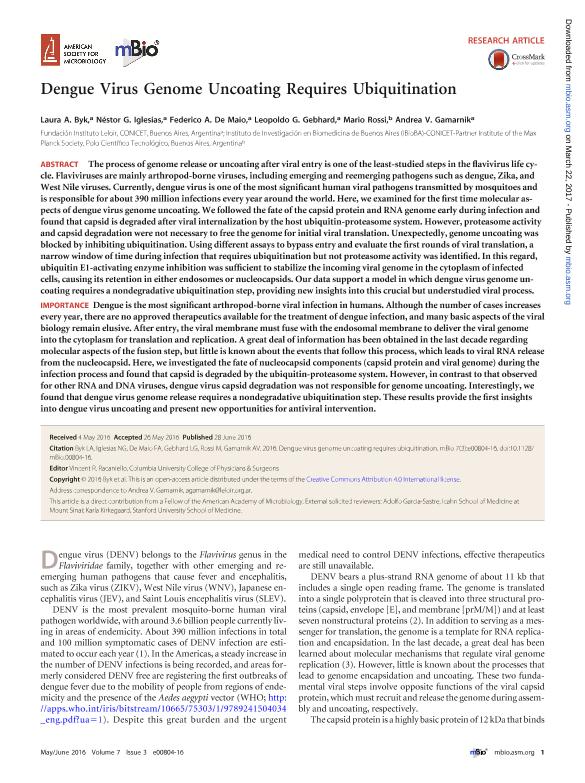Mostrar el registro sencillo del ítem
dc.contributor.author
Byk, Laura Andrea

dc.contributor.author
Iglesias, Nestor Gabriel

dc.contributor.author
de Maio, Federico Andres

dc.contributor.author
Gebhard, Leopoldo German

dc.contributor.author
Rossi, Mario

dc.contributor.author
Gamarnik, Andrea Vanesa

dc.date.available
2017-09-26T19:43:56Z
dc.date.issued
2016-06
dc.identifier.citation
Byk, Laura Andrea; Iglesias, Nestor Gabriel; de Maio, Federico Andres; Gebhard, Leopoldo German; Rossi, Mario; et al.; Dengue Virus Genome Uncoating Requires Ubiquitination; American Society for Microbiology; mBio; 7; 3; 6-2016; 1-10
dc.identifier.issn
2150-7511
dc.identifier.uri
http://hdl.handle.net/11336/25157
dc.description.abstract
The process of genome release or uncoating after viral entry is one of the least-studied steps in the flavivirus life cycle. Flaviviruses are mainly arthropod-borne viruses, including emerging and reemerging pathogens such as dengue, Zika, and West Nile viruses. Currently, dengue virus is one of the most significant human viral pathogens transmitted by mosquitoes and is responsible for about 390 million infections every year around the world. Here, we examined for the first time molecular aspects of dengue virus genome uncoating. We followed the fate of the capsid protein and RNA genome early during infection and found that capsid is degraded after viral internalization by the host ubiquitin-proteasome system. However, proteasome activity and capsid degradation were not necessary to free the genome for initial viral translation. Unexpectedly, genome uncoating was blocked by inhibiting ubiquitination. Using different assays to bypass entry and evaluate the first rounds of viral translation, a narrow window of time during infection that requires ubiquitination but not proteasome activity was identified. In this regard, ubiquitin E1-activating enzyme inhibition was sufficient to stabilize the incoming viral genome in the cytoplasm of infected cells, causing its retention in either endosomes or nucleocapsids. Our data support a model in which dengue virus genome uncoating requires a nondegradative ubiquitination step, providing new insights into this crucial but understudied viral process. IMPORTANCE: Dengue is the most significant arthropod-borne viral infection in humans. Although the number of cases increases every year, there are no approved therapeutics available for the treatment of dengue infection, and many basic aspects of the viral biology remain elusive. After entry, the viral membrane must fuse with the endosomal membrane to deliver the viral genome into the cytoplasm for translation and replication. A great deal of information has been obtained in the last decade regarding molecular aspects of the fusion step, but little is known about the events that follow this process, which leads to viral RNA release from the nucleocapsid. Here, we investigated the fate of nucleocapsid components (capsid protein and viral genome) during the infection process and found that capsid is degraded by the ubiquitin-proteasome system. However, in contrast to that observed for other RNA and DNA viruses, dengue virus capsid degradation was not responsible for genome uncoating. Interestingly, we found that dengue virus genome release requires a nondegradative ubiquitination step. These results provide the first insights into dengue virus uncoating and present new opportunities for antiviral intervention.
dc.format
application/pdf
dc.language.iso
eng
dc.publisher
American Society for Microbiology

dc.rights
info:eu-repo/semantics/openAccess
dc.rights.uri
https://creativecommons.org/licenses/by/2.5/ar/
dc.subject
Dengue Virus
dc.subject
Nucleocapside Uncoatimg
dc.subject
Ubiquitination
dc.subject.classification
Bioquímica y Biología Molecular

dc.subject.classification
Ciencias Biológicas

dc.subject.classification
CIENCIAS NATURALES Y EXACTAS

dc.title
Dengue Virus Genome Uncoating Requires Ubiquitination
dc.type
info:eu-repo/semantics/article
dc.type
info:ar-repo/semantics/artículo
dc.type
info:eu-repo/semantics/publishedVersion
dc.date.updated
2017-09-08T20:18:07Z
dc.identifier.eissn
2150-7511
dc.journal.volume
7
dc.journal.number
3
dc.journal.pagination
1-10
dc.journal.pais
Estados Unidos

dc.journal.ciudad
Washington
dc.description.fil
Fil: Byk, Laura Andrea. Consejo Nacional de Investigaciones Científicas y Técnicas. Oficina de Coordinación Administrativa Parque Centenario. Instituto de Investigaciones Bioquímicas de Buenos Aires. Fundación Instituto Leloir. Instituto de Investigaciones Bioquímicas de Buenos Aires; Argentina
dc.description.fil
Fil: Iglesias, Nestor Gabriel. Consejo Nacional de Investigaciones Científicas y Técnicas. Oficina de Coordinación Administrativa Parque Centenario. Instituto de Investigaciones Bioquímicas de Buenos Aires. Fundación Instituto Leloir. Instituto de Investigaciones Bioquímicas de Buenos Aires; Argentina
dc.description.fil
Fil: de Maio, Federico Andres. Consejo Nacional de Investigaciones Científicas y Técnicas. Oficina de Coordinación Administrativa Parque Centenario. Instituto de Investigaciones Bioquímicas de Buenos Aires. Fundación Instituto Leloir. Instituto de Investigaciones Bioquímicas de Buenos Aires; Argentina
dc.description.fil
Fil: Gebhard, Leopoldo German. Consejo Nacional de Investigaciones Científicas y Técnicas. Oficina de Coordinación Administrativa Parque Centenario. Instituto de Investigaciones Bioquímicas de Buenos Aires. Fundación Instituto Leloir. Instituto de Investigaciones Bioquímicas de Buenos Aires; Argentina
dc.description.fil
Fil: Rossi, Mario. Consejo Nacional de Investigaciones Científicas y Técnicas. Oficina de Coordinación Administrativa Parque Centenario. Instituto de Investigación en Biomedicina de Buenos Aires - Instituto Partner de la Sociedad Max Planck; Argentina
dc.description.fil
Fil: Gamarnik, Andrea Vanesa. Consejo Nacional de Investigaciones Científicas y Técnicas. Oficina de Coordinación Administrativa Parque Centenario. Instituto de Investigaciones Bioquímicas de Buenos Aires. Fundación Instituto Leloir. Instituto de Investigaciones Bioquímicas de Buenos Aires; Argentina
dc.journal.title
mBio
dc.relation.alternativeid
info:eu-repo/semantics/altIdentifier/url/http://mbio.asm.org/content/7/3/e00804-16.long
dc.relation.alternativeid
info:eu-repo/semantics/altIdentifier/doi/https://doi.org/10.1128/mBio.00804-16
Archivos asociados
